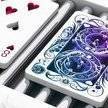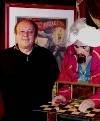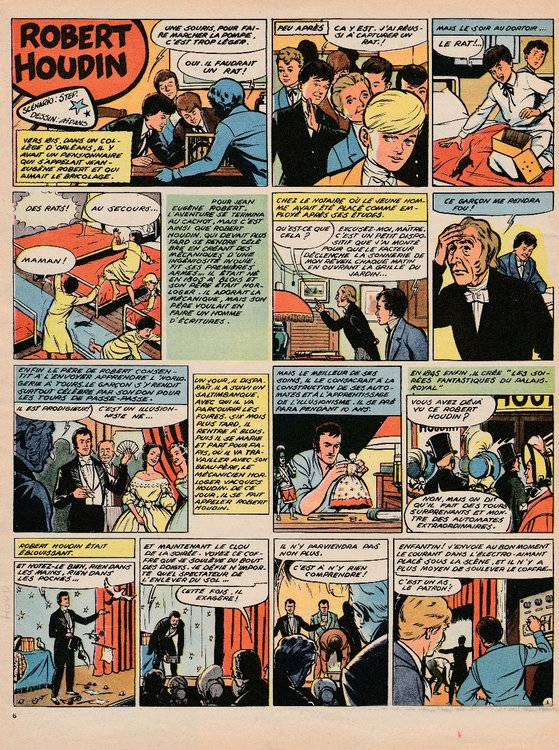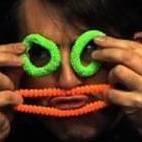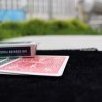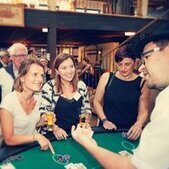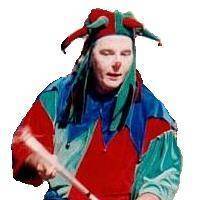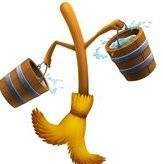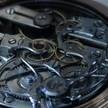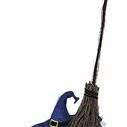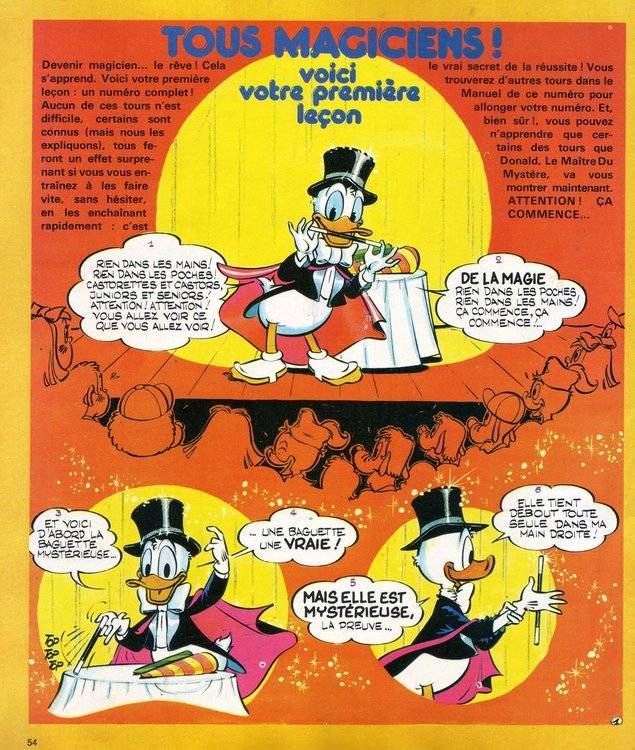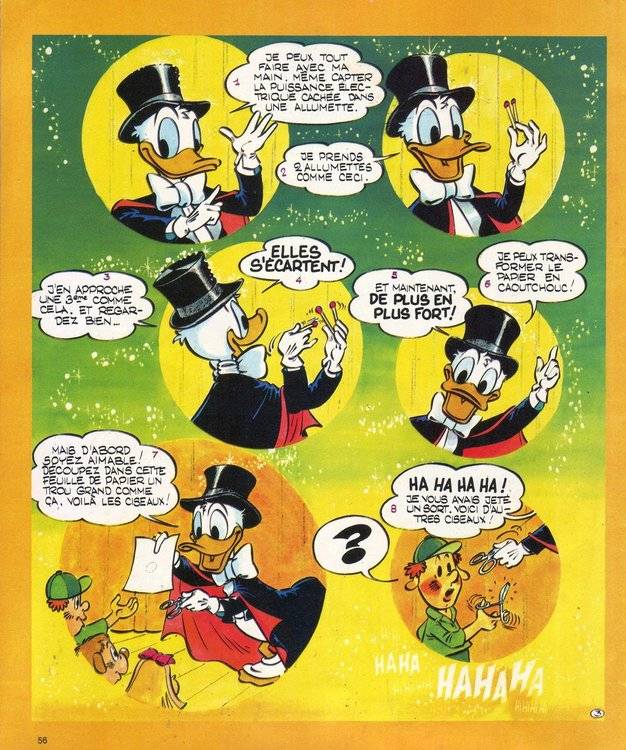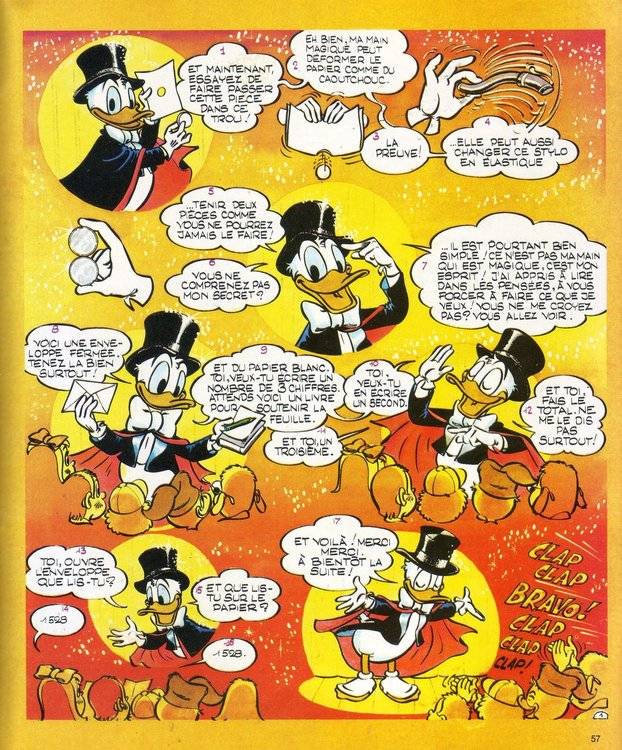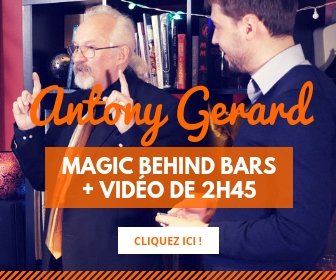Tableau d'honneur
Popular Content
Showing content with the highest reputation on 08/24/18 partout
-
3 points
-
Luc : 8 fois le même forçage en deux tours mais on en prend quand même plein les yeux...3 points
-
Si tu appelles une voyante, et qu'elle ne décroche pas avant que ça sonne, raccroche !3 points
-
Ah ça, les années 780 c'était le bon temps ! Avec ce bon roi Charlemagne... Encore que, quand il nous a forcés à aller à l'école, ça, c'était pas cool...2 points
-
Oui, elle est assez simple. Mais il vaut mieux regarder l'avant-dernière case en grand format (en tout petit, c'est presqu'invisible).2 points
-
A 21 h00 ce n'est pas une rediffusion mais le N° 3, la redif du N° 2 du 5 janvier 2018 est à 23h202 points
-
2 points
-
Je viens de terminer le set de DVD. Franchement, tout est à jeter. Aucun bon tour. Tellement simple à comprendre, vous ne blufferez jamais personne avec. Passez votre chemin, vous économiserez du temps et de l'argent.2 points
-
Technique du millefeuille argumentatif ? https://cortecs.org/wp-content/uploads/2017/01/CorteX_Indice_Moisissures-web.html2 points
-
Bonsoir, J'ai regardé les 2 premiers épisodes et j'ai pas trop accroché. Je ne suis pas un expert en magie mais j'ai l'impression que pas mal de chose sont faites avec des complices... J'ai préféré la série The road trick sur netflix aussi. Les tours sont assez basiques mais la découverte des villes et les rencontres effectuées rendent la série assez intéressante Bonne soirée2 points
-
J'ai découvert la semaine dernière un excellent blog, que vous pouvez aller visiter ici. Des réflexions à contre-courant sur la magie et les magiciens, par un magicien. Un autre regard, des ouvertures, des provocations, des remises en question, d'excellentes idées de présentation. Bref, du bonheur chaque jour. Désolé pour ceux qui ne parlent pas anglais (ça va râler, mais je partage quand même). Voici trois exemples d'articles que j'aime beaucoup: _____________________ Le spectateur coupe sur les as: 3 présentations (j'adore la version 3 ) Spectator Cuts to the Aces is definitely in my top 10 most performed tricks. I use John Bannon's Directed Verdict (or one of the variations) which is pretty much perfect. I almost always let the spectator shuffle first by holding out the aces and then palming them in. Actually, that's a lie. I don't "hold out" the aces and "palm them in." But there isn't really nomenclature that exists for a lot of the methods used in informal magic. The truth is the aces are in my hoodie pocket or behind a pillow on the couch, and then I just put them on the deck when they're not looking. Version 1 - The No Patter Version Spectator Cuts to the Aces is one of those tricks that magicians haven't really found a way to mess up with bad patter. It's a pretty pure trick, and I'm happy to present it that way. I'm not always advocating for a deep, world-building presentation. I just think those are the most fun to perform, interesting for the spectator, and they stay with them the longest. But remember that part of my patter algorithm I talked about earlier in the week is that if the patter isn't strong enough to stand on its own, then I dump it. So I'm not against a bare bones presentation, they just don't have the same long-lasting impact and are more for transient enjoyment. And that's fine, in fact it's a good thing for the non-pro performer to not always hit the same notes in a performance. Look, sometimes you want a long slow seduction that lasts half the night, sometimes you want to flip her skirt up and bend her over the kitchen table, and sometimes you just want to make-out on the couch in your underpants. The reason your love-life is so stale isn't because you're a terrible fuck. You've just been in a tired routine, possibly for years. Change things up. Okay, the truth comes out, this isn't a magic blog. Your wife hired me to get this message to you, and this was the only way I could think to approach you with your guard down. Where was I? Yes, mix your style up. The truth is, even when I perform with "no" patter, there is kind of a meta-patter going on. I'm about to give you a gift and give you the line I often lead into these performances with. I'm not exaggerating when I say it's a gift. It's a line that will have your spectator significantly more engrossed in what you perform. But I only use it on someone who has seen me perform something grander and more involved sometime previously. I don't say, "Want to see a trick?" I say, "Can I get your opinion on something I'm working on?" or "I've got something new I'm trying to work the kinks out of. Can I show you? I think you'd be perfect for this." Or any similar words that express: 1. This is a work in progress. 2. I specifically want to perform this for you. We seriously undervalue the inherent interest in giving people a behind the scenes look at this type of work. If someone has seen you perform something that blew their mind in the past, I guarantee you that they are so primed to see "something you're working on." What often prevents people from going down this route is -- as I've mentioned all week -- that it conflicts with their need to be seen as real. "I can't ask someone to see a 'rough draft' because that would imply I'm not really psychic." Okay. Keep shooting yourself in the foot. I don't want to come off as in love with my ideas if they're really not that great, but I truly believe there is magic in this line. It flips a switch in people. It's intriguing, flattering, and best of all, it's true. All our effects are works in progress, and you should want to perform it for that specific person (or else why bother?) and value any opinions and insights they can give. If it's still not clear why this is powerful, imagine this scenario... You go to your friend's house and he says, "Do you want to see the windmill photos I took that they're going to display at the coffee shop?" You say, "Sure." Now, unless you have some particular interest in windmills, you're going to flip through those things quick as shit so you can get on with your night. But if he says, "I'm really glad you're here. I was hoping I could get your thoughts on which of these windmill photos I should give to the coffee shop to display." You still have no interest in windmills or photography but now you're giving each one a good look, comparing composition, really getting into it. All that has changed is your friend went from showing you something to making you a part, however small, of the process. That makes people feel valued. And that stays with them. Version 2 - The Ocean's Eleven Version Spectator Cuts to the Aces isn't really a gambling trick, but I sometimes make it one. Gambling tricks are notoriously bad as far as presentation goes. They're either just demonstrations of skill, or they're these passive, dull stories about some old poker game you were supposedly in. I'm going to give you a generic gambling presentation that you can use for most gambling routines. It's really just a set of rules I apply to the way I present gambling tricks. I make it active. (As in it takes place in the present tense. I'm not repeating some story about a game that didn't happen.) I make it urgent. It's not a demonstration or a trick. It's a rehearsal. So for Spectator Cuts the Aces... You [acting all coked up]: Oh, dude, I'm so glad you're here. I need your help with something. Take a seat. Mix these up. Wait, wait. Not there. That's where the Brazilian will be sitting. I need you to sit here. Okay cool. Now I need to try something. Cut a small portion of cards off the deck. Actually... wait... put that back. He's left-handed. So I need you to do it with your left hand. Great. Okay, now another. And another. And one last one. Let's see what we've got. [You turn over a 4 of hearts, 8 of hearts, King of clubs, and 7 of diamonds.] Fuck! Fuck, fuck, fuck, fuck, fuck, fuck, fuck, fuck. What the hell happened here? Goddammit. I just can't.... Hold on. [You go in the other room and can be heard making a phone call.] Call it off man, we're done. It's not happening [Pause] Listen dude, I said it's DONE. It's not going to work. So what the fuck are we doing this for? To get ourselves arrested or killed? No, I'm out. Find someone else. [Pause] What do you mean? I just tried it again. [Pause] No. Not one. [Pause] I don't know. You tell me, dude, because I sure as shit don't know. [Pause] No. That won't work. [Pause] Because it won't, that's why. We can't... wait. Wait, wait, wait, wait, wait, wait, wait, wait. Hold up. Is there any way we'll have access to the lighting in the room? [Pause] And Johnny can do that, right? Hold on, I need to try something. [You hang up and go back into the room with your friend.] Look, I'm going to tell you something, but you have to promise not to tell anyone or I'll rip your throat out. I swear to god. We have a big score coming up. Potentially a life-changing one. I got into a poker game this weekend that could set me up real nice for a real long time. I've got a crew together. We were supposed to have another couple months to figure this out, but the sultan's daughter threw a fit and got her wedding moved up and now they're in town this weekend. So we're trying to rush this shit, but it's not working. We have a way to introduce our own jeux_de_cartes into the game, but it's all going to fall apart unless we can get the sultan to cut exactly where we want him to when it comes around to him. I'm killing myself trying to figure this shit out. But I might be onto something. [You lower the lights in the room just slightly.} Here. Cut the cards into four piles again. Here, here, here, and here. Turn over the cards you cut to. [They're all aces.] Oh my god. This is going to work. This is going to work! [You take your friend's face in your hands and kiss him square on the lips.] You can end here, with your friend wondering how the hell he cut to the aces by you adjusting the lighting, but I would take it further. [A couple days later, rent a bright yellow Lamborghini. Drive to your friends house and lay on the horn until he comes outside. Roll down your window.] Hey dude. We did it. We fucking did it. It didn't go exactly as planned but we got that fucking money. Oh, I have something for you. [You unzip your jacket to reach into an inside pocket. It's at this point your friend notices that you shirt is covered in what appears to be blood. You pull out a (fake) Rolex from inside your jacket.] I want you to have this. You keep your mouth shut, okay? [There are specks of blood on the watch. You roll up the window and drive away. Never contact this friend again.] Version 3 - The Creepy Child Version The idea of using an ace cutting routine to cut to something other than the aces is a good one. This presentation uses that idea. Your friend, Lisa comes over to have dinner and watch a movie. On the coffee table is a crayon drawing done by a young child of a jumbled bunch of cars. "What's this?" she asks. "Oh," you say, "My niece came over a couple days ago. She loves to draw. I actually told her all about you. She loved hearing about your cat. Oh wait! Want to see something weird? Look at that picture again. Now look at the cover of today's paper. Doesn't her drawing look way similar to the photo of this accident in the paper? I mean, it's not identical, of course. But it's like the same number of cars and this tree is in the same position. But she drew this three days ago. And that accident just happened yesterday. I mean, I know it's just a coincidence but it still freaked me out a little. Her mom is always telling me she has these visions that come true but her mom is such a flake. She also claimed that her grandmother had these visions as well, but then her grandmother got hit by a bus. So much for seeing the future, right?" "Hey, can I get your opinion on something I'm working on?" You perform the effect. "Wouldn't it be amazing if you cut to the four aces?" You turn over the first card, it's the ace of diamonds. The next card is the ten of diamonds, followed by the four of clubs and the six of hearts. "Well, that needs more work. I think maybe you shuffled too much. Eh, it was worth a shot. Where should we order dinner from? I had chinese last night so I'd rather..." As you talk your eyes fall back onto the cards Lisa cut to and your voice fades off. "No way," you say, getting off the couch. You grab Lisa's hand and pull her with you to the kitchen. Stuck with a magnet to the refrigerator is a child's drawing of the ace of diamonds, the ten of diamonds, the four of clubs, and the six of hearts. You stare at it for a moment. "I thought she just drew it because she knew I like magic and playing cards. I never imagined..." You pull it off the refrigerator and bring it back to the other room to compare it to the actual cards, just to be sure. "This is just so weird..." Later that evening as you're clearing the coffee table to get ready for dinner, you move a magazine and another drawing that was under it falls to the floor. Lisa picks it up. It's a stick figure drawing of a woman riding a man in bed, her head thrown back in ecstasy. In a child's scrawl it says, "Uncle Andy" with an arrow pointing to the man, and "Lisa" with an arrow pointing to the woman. You look at it with Lisa. "Ha, wow... that's just... I mean... I'm sure she didn't know what she was drawing... kids just.... well.... they just have the craziest imaginations... don't they?" you say, as your hand brushes some strands of hair off her forehead and behind her ear. If you can't parlay that into some action, you're hopeless. _____________________ Cadavre exquis “An illusion has three stages. First there is the setup, in which the nature of what might be attempted at is hinted at, or suggested, or explained. The apparatus is seen. volunteers from the audience sometimes participate in preparation. As the trick is being setup, the magician will make use of every possible use of misdirection. The performance is where the magician’s lifetime of practice, and his innate skill as a performer, cojoin to produce the magical display. The third stage is sometimes called the effect, or the prestige, and this is the product of magic. If a rabbit is pulled from a hat, the rabbit, which apparently did not exist before the trick was performed, can be said to be the prestige of that trick.” — Christopher Priest, "The Prestige" This is one of my favorite things I've posted. It's a continuation of last week's post on the Phil Deck, but it's a lot more than that (and you don't necessarily need a Phil Deck to do it. I'll explain a regular deck handling at the end.). It started off as just a way to present a separate effect and I performed it that way a few times. But then it became an effect itself. You'll see. The Setup The idea is pretty simple. You show your friends a deck of cards. On the backs of the cards are a bunch of words: nouns, verbs, and adjectives. You shuffle up the cards as you tell your friends that you're trying to increase your magic creativity for competition you're entering. ("First prize is a date with Melinda, The First Lady of Magic. Ten runners up get a subscription to True Mysteries which is a service that sends you the blueprints for magic effects in the mail once a month. I'm already a subscriber but it would be nice to get it free because it's pretty expensive. And 100 entrants will be randomly picked to be guest editor for a day at thejerx.com, the world's greatest magic blog.") The competition is a test of magical improvisation so you've created this deck to push your creativity to the limits. You pull out a piece of paper and it says: http://img11.hostingpics.net/pics/246234mag1.jpg "So what I do is I mix up the deck, then choose four random cards to complete that sentence." You finish shuffling and take a few cards off the top of the deck and place them on the paper so they make a sentence. FLOAT a HARMONICA with a DOG BISCUIT in a MESSY way. "And then I challenge myself to to accomplish this trick. I usually give myself like 30 minutes to think of something and if I can do it I give myself a point in the win column, if not I give myself a point in the loss column." You turn the page over and there are three marks in the win column and eight in the loss. Clearly this is pretty challenging. You spread through the deck to show them a bunch of different words. The nouns are all things that might be found in your home. The verbs are all magic related words, e.g. "tear and restore," "change," "penetrate," etc. And the adjectives are just adjectives: fast, painful, scary, sexy. You ask your four friends to each think of a card. You ask one to think of heart, one a spade, one a club, and one diamond. You do this so they don't think of the same card and so you get a mix of different types of words. (All the verbs on diamonds, adjectives on hearts, etc.) The four people each tell you their card (or one person tells you her four cards), and you pull them out of the deck. You say, "Your choices are now the foundations for this trick." You pull out a couple other cards as examples. "You said the 4 of clubs, on the back it says 'Egg.' If you had said the 5 of clubs we would have gotten 'Skateboard.' You chose the 10 of diamonds which is [you turn the card over] 'Vanish.' If you had picked the 8 of diamonds it would have been, 'Tear and Restore.'" You show the back of the 8 of diamonds and then put that card back in the deck and for the last time you spread the deck face down so they can see all the different words they theoretically could have picked. You take the four cards they named, turn them over, and put them into their proper parts of the sentence. VANISH an EGG with a BICYCLE in a FIERY way. http://img11.hostingpics.net/pics/246140mag2.jpg The Performance "Awww.... what the hell...," you say and let out a big, long sigh. You drag your bike in from the garage and get an egg from the kitchen. You just stare at them both for a few minutes. "Feel free to watch some tv or something," you say. You wait a while. Every now and then you get up and try and balance the egg on the bike seat, or spin the wheel slowly and try and place the egg through it. After each little brainstorm you sit back down and just stare intently at the bike and egg. Eventually you jump up excitedly, get your friends' attention and vanish an egg with your bicycle in a fiery way. And how do you do that? Bitch, I don't know. It's just an example. In this scenario you've stumbled upon a way to vanish an egg with a bicycle and some flash paper and the Mad Lib Ploy is how you're getting into it. Let me be clear -- and if you've received the emails that I've received you'd understand why I need to make this clear -- this post is NOT about how to vanish an egg with a bicycle. This post is about justifying any trick you have that makes use of apparently random items. The Reasons But why bother using a Phil Deck to get into a trick like this? Why not just vanish an egg with a bicycle (or whatever)? Multiple reasons: Making it seem improvisational is more interesting to your audience. It feels like this is a unique moment, not something you're prepared for. Their choices are the DNA for this trick. You're giving them a backstage peek into the process of creating magic (supposedly) which is inherently interesting. Take your weaknesses and make them strengths. You're taking a non-organic trick with these random items and -- by giving it a context -- you're making the complete randomness a feature of the effect. It's something you're highlighting. There's no reason to do this presentation if you're going to force the phrase, "VANISH the CARD with an ENVELOPE in a MYSTERIOUS way." The whole purpose of this presentation is to give a context to an effect you have that utilizes seemingly random props. People often think, "Well, this effect uses ordinary objects, therefore it's an 'organic' effect that I don't need to justify." But using ordinary objects out of their normal context isn't that much better than using an obvious magic prop. You can use a brass chop-cup and a crocheted ball to do an effect and they might think, "Hmm... there's probably something special about that cup. It doesn't look like any ordinary cup I've used." Or you can use an empty tin can and -- unless you're in a recycling center -- they might think, "Hmmm... there's probably something special about that tin can, or else why would he have brought it here to this wedding reception?" The Method As I've already indicated, you're using a Phil deck, but instead of one force item, you're using it to force four different words. Simple. Later, I'll discuss a non-gimmicked deck option. In theory this could be the end of the idea. But I prefer to take the whole presentation one step further into... The Prestige You wipe off your brow, sit back on the couch and give yourself a point in the win column for successfully executing the trick. You start cleaning up a little and put the pad of paper away. You take your mail off the table and flip through it. "Oh," you say, "this is that subscription service I'm hoping to win. The one that sends you magic blueprints each month. It's like $600 a year if you can believe that." You show them the envelope and then tear into it. http://img11.hostingpics.net/pics/503122mag3.jpg "Oh, fuck me," you say. "It would have been so much easier to do it this way." And you drop everything to the table. http://img11.hostingpics.net/pics/311982mag4.jpg Your friends are confused and astonished. They pick up the deck of cards with the words on them and spread through them. All the words are different. Only their choice of cards would create the effect that was on the blueprint in that envelope. You let it slowly dawn on you that this is quite a coincidence. "Wait... that's impossible, isn't it? This company is pretty fucked up. Sometimes they respond to emails I've only thought of sending them. And remember I said it's $600 a year? Well they take 15% off if you send them a chunk of your hair, but it can't be cut, it has to be pulled from the root. What could that be about?" you say, rubbing the back of your head and staring off as you relive the painful memory. The End. Rationale I know what some of you are thinking. You're thinking, "Oh, Andy, you just spoiled the whole feeling of the main trick being improvisational by having that reveal at the end." Well... yes and no. Yes, it does somewhat, but not necessarily any more than any prediction "spoils" the whole feeling of fairness in regards to whatever selection procedure was being used. And remember what the purpose of "creating" the effect from "random" words is. The purpose is not to make the audience believe I'm a genius at creating magic effects in a completely spontaneous nature. They may have that impression in the middle of the performance, but I don't mind tearing that down at the end. The purpose is to get them interested in the effect and engaged in the moment in a way they wouldn't be if I just said, "I know how to vanish an egg with a bicycle." At this stage of the presentation, those benefits of the selection procedure have already been wrung dry. So when I reveal the prediction (which in this case isn't really a prediction) it turns the whole "random word selection procedure" into an effect itself. And if you follow this from beginning to end, it's like a 20 minute suite with separate movements. All of which are very different but intriguing in their own way. Part One: You capture their attention with the idea of a completely original trick. One that their decisions will help create and one you couldn't possible have prepared for. Just the notion of a deck of cards as a random sentence generator is interesting itself on some level. Part Two: They get to see you in your brainstorming phase. I've been harping on this since I started this site, but don't underestimate how much people will enjoy this type of thing. It's fun for people to watch the process of creation and see things in an unfinished stage. Part Three: Now they are seeing an actual magic trick. Vanishing an egg with a bicycle. Or making a bowling ball appear from a pizza box. Or tearing and restoring a skateboard with a puppy. Whatever. It should be a seriously incredible trick. I would not go creating a half-assed trick with random items just so you could do this larger presentation. Wait until you have a real mindblower that's strong enough to stand on its own, then incorporate it into this performance piece Part Four: After witnessing a truly strong magical performance, the twist ending transforms the nature of the entire experience. I would not just pull out a prediction at the end and say, "I knew what cards you would name." That's a little too dull and a little too much of a fuck-you to the premise you established. Instead, by making it a wild coincidence (as opposed to a prediction), the other three "movements" still stand on their own within the context of the trick. If you could "predict" what cards they would name (and thus what words you would end up with), then the part where you're brainstorming ideas would just be a nonsensical waste of time. This is not to suggest the audience will really believe in this mail-order magic blueprint company that just happened to send blueprints for an effect that was seemingly created on the spot. They understand it presents the same impossibility as a "prediction." But by not treating it like a prediction or claiming responsibility for it, the integrity of the story of the complete piece makes sense. Examinability After the words were picked originally, you have the word-deck in your hand. The four cards are turned over and the sentence is unveiled. You then get up to go get the items mentioned on the backs of the cards. When you're in the garage getting the bike (or whatever), you have all the time in the world to swap out the force deck for a normal 52-card deck (that is similar to the Phil deck in its distinctive quality) that truly does have random words all over the back. You remove from that deck the 4 cards that were named by the spectators. Then when you return to the room, you just place that deck back on the table. As far as the audience is concerned, that deck's purpose was complete minutes ago. So they won't even notice you leaving and returning with it -- it's a completely natural action. Now this is an incredibly strong convincer after the twist is revealed because they can now pick up the deck and examine everything and nothing is amiss. No other cards would have created that effect or matched the blueprint in the envelope. You might think they'll think something is up with the 52 cards of a Phil deck. They won't. If the cards are not in a card case, and are just spread around on a table, the deck seems full enough. If anything they will just feel like cheap cards to a spectator. If you're concerned, when you introduce the deck in the beginning you can say you got it from a dollar store, but the cards were too cheap to use regularly so that's why you're writing on the back of them for this trick. But it's not necessary unless you're performing for someone who handles playing cards on a very regular basis. (And just to be clear a Phil deck is not the same thing as a "Double Decker" deck. 52 cards of that type would not withstand handling by the spectators.) The Non-Phil-Deck Method This presentation allows you to use a regular deck, if you want. I don't know that I would, but it would be easy enough to and it could almost be handed out for examination -- at least in a more formal performance where audiences tend to give things rather cursory examinations. It would still need to be switched to have a fully examinable deck at the end, but could withstand a brief examination at the beginning. You have to exercise a bit more control on which card everyone thinks of, but with this presentation, where different cards have different types of words (and you need particular types of words) I think the limitations make sense. So you say to four people, "In a moment I want you all to think of a value of a card. Not a suit, just a value. I don't want you all to think of the same value because that would be too easy [whatever that means]. So you two, [indicate the people to your left] think of an odd value, and you two think of an even value. We need different types of words. The verbs are on diamonds, so attach your value to a diamond. The adjectives are on hearts. You'll be our adjective person so whatever value you are thinking of make it a heart. [You address these statements to the people on your left.] The nouns are all clubs and spades. So make your card a club, and your card a spade. Got it?" Then they name the cards they were thinking of and you're ready to go. So let's look at the breakdown of the deck and you'll see why it works especially well in this presentation. First, there are 28 cards they can't name (even red cards, odd black cards, two jokers), on these 28 cards you will write 28 random words. A mix of nouns, verbs, and adjectives. These cards can be freely shown to your spectator. On the seven odd diamonds you write adjectives, but they should be seven different adjectives that could all apply to the trick. In the example, I used the force word "fiery," imagining an egg vanishing in a flash of fire. But you can easily imagine other words that would apply to that type of trick as well: hot, bright, dangerous, quick. And then you can add some adjectives that just require you to embody a particular attitude: sexy, funny, mysterious. With seven different adjectives we now have 35 cards that can be freely shown. With the three actual force cards/words it's 38. And then if you can think of any synonyms for the nouns and verb you're using (disappear instead of vanish; bike for bicycle; food or breakfast for egg), you can easily have about 42 cards that you can freely show. Think of that. You can cleanly display about 80% of the deck and yet it will force one very specific trick with four "freely" thought-of cards. Stage Version This would translate amazingly well to stage. Imagine this. You come out on stage and talk about this creative exercise you used to do with a deck of cards and random objects. And you talk about how much you liked this exercise because it was always challenging and kept you in the moment. And at first you thought of it as more of a mental exercise, but now you realize that it deserves to be put in front of an audience. "These cards can create over 100,000 different trick descriptions. So that means that what you see tonight will not only be a first for you, but it's also a first for me, and because of the randomness it will be a first for anyone ever. A brand new trick that has never been performed anywhere." Onstage there is a small mass of items. "I asked the stagehands to assemble some items from backstage. We have wigs, pillows, framed posters, a can of beer, instruments, and so on. They also wrote the names of the items on these cards as well." You go through the selection procedure and get the sentence: PENETRATE the MANNEQUIN with a UKULELE in a DANGEROUS way. "Hmm, this should be interesting," you say. You sit at a table on stage for a few minutes (yes, actual minutes) just thinking while a live cellist plays for the crowd. After a few minutes you bolt up and start moving things around on stage. Once everything is in place you proceed to penetrate a mannequin with a ukulele while standing on one leg on a skateboard with thumbtacks all over the ground. The audience applauds wildly. You step down and accept their applause. Someone comes out and sweeps up the thumbtacks. "Thank you, ladies and gentleman. That means a lot to me. You know, I come from a magic family. My great-great-grandfather was Brooks the Magnificent. And while you might think for a lover of magic like me that would be a blessing, I have actually spent a long time living in his shadow. And Brooks the Magnificent casts a large shadow. My family did not encourage me to practice magic. We are pretty much estranged now. And before we were I was constantly being compared unfavorably to my great-great-grandfather. So to be able to come here and perform something like that -- an original miracle that has never been seen before -- well, that means the world to me.” You start putting the props back on the prop pile. "It's actually almost life-affirming, in a way. My great-great-grandfather was an incredible magician, but not a great man, and the ramifications of that are still being felt in my family today. So to be able to do something he could never dream of accomplishing means so much to me." As you're returning the items one of the poster frames that was leaning against the pile falls backwards on to the floor. For the first time you see the face of the poster. "What the FUCK?!" you scream. You hold up the poster to the audience. It's a handsomely painted old-time magic poster that reads, "Brooks the Magnificent presents 'The Amazing Ukulele thru Mannequin Penetration!'" With an old-timey guy in a tux balancing on one leg on a skateboard and penetrating a mannequin with a ukulele while some ghostly spirit looks on approvingly. The performance ends with you running off stage and the sound of a gunshot behind the curtains. _____________________ Le tour qui rate Today I have a small tip on how to improve your performance of any effect with a "Magician in Trouble" premise. This type of presentation gets a lot of heat from other magicians because it's used all the time and it's rarely very convincing. I have a theory as to why. I think a lot of magicians have such low self-esteem that they don't want people to think they messed up even for 15 seconds. So they say, "It's your card, the five of clubs." And when the spectator says that's not their card the magician's voice goes up a couple of octaves and he's like, "Whaaaaaa??!!!! That's not it? Damn it! Well maybe this is it. The jack of diamonds? Thank you." The question is why are you bothering going through the machinations of the Magician in Trouble ploy if you're not giving it any chance to register as a real thing? What do you think you're gaining over just revealing the correct card in the first place? Just knock it off. Be the magician who gets things right if you're too uncomfortable being the one who gets things wrong. For the others of you who really want to sell this premise, here is my tip. Let's say a Magician in Trouble effect has four parts: The body of the trick The fake climax of the trick The aftermath of your mess-up The real climax of the trick. So often we think about how we should act after we've messed up -- part three. The standard advice is to have a mental script that you're going through. Not one that you're saying out loud, but one that you're thinking. In other words, the usual advice looks at Magician in Trouble as an acting problem as in "How do I act like I messed up?" What I've found works best for me is, instead of focusing my energy on how I act after I mess up, I instead focus my energy on part two, the fake climax. Magicians will often not give this much thought because why would they? It's something that's meant to go wrong. But if you really want your audience to buy into the notion of you messing up, then put your heart and soul into the fake climax. If you just say, "It's your card. The jack of hearts.... oh, it's not?" People may or may not believe you screwed up. But if you take your spectator's hand in your right hand, then wave your left hand slowly over the deck. And if, while you're doing this, you talk about the "magic" of human connection and your ability to locate her card via the bond that we all share as people. And if you pick up one card, then discard it and have your attention drawn to another and pick that one up instead and let a big smile come over your face and then say something like: "When you tell your friends what happened here tonight, they might not believe you. These days, perhaps, we're all too old and savvy to believe in real magic. But you will know that it really did happen. And it wasn't some ethereal notion of 'magic' that made this possible. It was our bond... [pause] and the power... [pause] of human connection!" You punctuate this last statement by turning the card over in a dramatic gesture and slapping it on the table. It's the wrong one. Yes, you will look like a huge fucking turd for a few moments. But if you really want to toy with your audiences emotions, expectations and experiences throughout the trick, then that's a good thing. What you do after that is less important. You don't have to "act." Just look through the cards or something. If you put enough passion into the build up, you will be embarrassed for yourself. Good. That's what you're supposed to be feeling in this moment anyway. Now when you bring the trick to a successful conclusion -- when you toss the cards in the air in frustration and their card gets impaled on a ceiling fan blade* and you say, "Oh right, that's where I screwed up. It's not the power of human connection. It's the power of ceiling fans." -- there is a genuine release of tension for both you and the audience. To put it succinctly, put your effort into building up the triumphant execution of the trick during the first fake climax rather then worrying about how you should act after you "mess up." People will be less likely to think you'd put all that effort into something you knew would go wrong and they will believe you regardless of your acting ability. * Take a duplicate card and rip a slit through the middle of it. Then put that on the corner of one of your ceiling fan blades. Turn on the fan, if the card doesn't fall off, you're good. If it does, put some tape on the top of the fan blade to hold it in place. Invite someone over. They won't notice a card on a spinning ceiling fan blade. Force a duplicate on them. Do the Magician in Trouble gambit and let them think you fucked up. Spread through the cards as if you're wondering what went wrong. After a few beats say, "You know something? Fuck these gay-ass card tricks," and toss the deck in the air towards the fan in such a way that they scatter in the air. If people don't notice, bring their attention to the card on the fan blade. Sit back on the couch and lock your fingers behind your head and kick your feet up on the coffee table. "I was a Magician in Trouble. Now I'm a Magician at Ease. Thank you, The Jerx!" And give a big thumbs up to no one.1 point
-
Barking Dog d'Étienne PRADIER permet de faire voyager la carte du spectateur depuis un jeu de cartes vers une pince. Barking Dog est un gimmick d'Étienne PRADIER qui permet de faire apparaître une carte, signée, au préalable perdue dans un jeu de cartes. Cette carte signée sera au final celle qui se trouve être emprisonnée, depuis le début du tour, dans une pince à dessin... @Johan R. nous propose son test ici : virtualmagie.com/articles/tests/matos/barking-dog-etienne-pradier Quels sont vos retours ?1 point
-
J’ai le plaisir d’accueillir chez moi ce champion du monde chinois en cartes. Attention, Il n’y a que 20 places. Réserve tout de suite ta venue ! Pour remercier les plus rapides, la place est à 39€, pour les dix suivants on passe à 49€. A toi de jouer… La conférence sera traduite de bout en bout. Vendredi 30 Novembre 2018 19h Apéro dinatoire tous ensemble en compagnie de Bill CHEUNG 20h30 Début de la conférence > Réservez tout de suite (les places partent déjà) et bénéficiez du tarif privilège : virtualmagie.com/boutique/conferences-ateliers/bill-cheung-30-novembre-paris Bill CHEUNG est un magicien chinois qui vit depuis quelques temps en Autriche . Son numéro présenté à la FISM a attiré rapidement l’attention des magiciens du monde entier de par son originalité et créativité. Lors des dernières sessions au congrès FFFF, Bill a suscité un réel engouement auprès de la confrérie magique. Ce jeune et talentueux artiste apporte vraiment une autre dimension à la magie contemporaine ! Sa routine de carte montante est dores et déjà considérée comme une pièce unique de la magie de ce 21eme siècle. C’est la toute première fois que Bill présentera sa conférence en France. Fortement recommandé… Contenu de la conférence Son effet de carte montante avec n’importe quelle carte désignée Un effet de pénétration avec des pièces juste incroyable Le tube de Ramsay ; un classique que l’on voit très peu présenté Un jeu qui change de couleur Carte retrouvée dans un endroit impossible Une routine avec des jetons de poker et bien plus… Notes de conférence en Français Matériel à la vente Bill CHEUNG présentera son numéro FISM. Un must à voir absolument ! > Réservez tout de suite (les places partent déjà) et bénéficiez du tarif privilège : virtualmagie.com/boutique/conferences-ateliers/bill-cheung-30-novembre-paris @Guillaume NATAS sera de la partie. Qui d'autres ?1 point
-
1 point
-
C'est bien mais, ça fait longtemps que j'ai pas regardé cette chaîne et je trouve qu'elle a quelque chose d'encore plus profond que les boîtes de magiciens : leurs tunnels de pub, c'est horrible...1 point
-
1 point
-
1 point
-
Laisse Shiva tenter un argument-massue qui s'oppose au tient dit du "coup de marteau" (pour prouver la "réalité"), sur ces questions on est sans doute tous complètement à la masse.1 point
-
Tout à fait. Moi je ne l'avais pas trouvée ! Elle n'est pas facile. Tu es fort !1 point
-
C'est le "Tour du Martien" de Jack Birnam présenté à la sauce ACAAN !1 point
-
En fait non pour aborder sereinement les 2look oll/pll... Ca semble bien plus efficace pour les 2look oll/pll mais la méthode commence par 7 algo pour les cross oll et 6 algo pour les pll... C'est un excellent début qui donnera des temps records... Mais trop difficile pour moi. Comme je le disais je ne suis pas assez assidu et donc je n'emploie aucune de ces méthodes d'apprentissage car je n'ai pas assez de temps et de mémoire disponible pour le cubing... J'ai donc fait ma propre synthèse en ayant pour objectif d'avoir le moins de cas possible à reconnaître et le moins d'algo possible à apprendre (avec, évidemment, une efficacité maximisée). Je n'ai conservé que : 2 look oll : 1 algo pour la croix jaune (algo classique des méthodes débutants/avancés) 1 algo pour l'orientation de la face jaune (qui peut être répété jusque 3 fois- je suis donc en train d'apprendre un autre algo pour supprimer les triples répétitions) 2 look pll : 1 algo pour positionner les coins 1 algo pour la permutation de la face jaune (cet algo peut au max être répété 2 fois-mais, à l'instar des oll, je suis en train d'apprendre un autre algo pour supprimer les cas qui amène une répétion) Ces algos ont l'avantage d'être des algo de la méthode fridrich et donc permettent d'introduire petit à petit de nouveaux algos de la méthode fridrich afin d'enrichir sa "bibliothèque mentale" de résolution. En effet, je n'ai pas l'intention d'aller au bout de la méthode fridrich qui demande une certaine abnégation... Assez souvent ces algo s'avèrent être le chemin le plus court pour des résolutions de type 2look. Parfois, certains cas nécessiteront la répétition du même algo... On perd donc du temps, mais d'un autre côté on gagne très rapidement en automatisme. Je commence tout doucement à introduire des algo pour supprimer les répétitions, ce qui permet d'apprendre algo par algo, à mon (très lent) rythme. En ce qui concerne les F2L, j'y vais tranquillement plus par logique et intuition que par apprentissage et application d'algo (je crois qu'il y en a 41, de mémoire...) : on gagne plus de temps à procéder sereinement avec un bon look ahead plutôt que de vouloir des le début chercher le chemin le plus économique. A l'occasion, si ça intéresse des gens, je développerai plus précisément ma méthode.1 point
-
Dans Cube3 Steven Brundage évoque à de nombreuses reprises BadMephisto, et c'est effectivement une très bonne source: https://defhacks.github.io/badmephisto-mirror/guide.html Il avait publié un pdf regroupant tous les algos de base (<>70) avec différentes variantes (2look PLL/OLL, 1look OLL/PLL, toutes les config de F2L). Il y avait tout sur ce pdf qui tenait sur 2 pages et pourtant très clair! Malheureusement je n'arrive pas à remettre la main dessus, mais il doit y avoir moyen... Je suis a peu près sûr qu'il était fourni avec Cube3 à sa sortie. A partir de là, pour aider à la mémorisation, le site alg.cubing.net est une tuerie, surtout pour les F2L car ce ne sont pas des algos à apprendre par coeur mais des stratégies à comprendre et à reproduire. Ex pour visualiser une stratégie de résolution pour un cas de F2L: https://alg.cubing.net/?alg=d_(R-_U-_R)_U2_(R-_U_R)&stage=F2L&type=alg Je m'étais fait une base de solutions aux F2L les moins intuitives (pour moi) en choisissant des solutions qui coulent bien sous les doigts (à base de R, U, U', etc...), puis pour m'entraîner je les chargeais au hasard. En visualisant le cube on cherche comment on résoudrait ce F2L, puis un clic sur play permet d'obtenir la solution pertinente (toujours la même, c'est ce qui permet la mémorisation). Quand on débute, les solutions suggérées sont bien meilleures que celles auxquelles on avait pensé... Le but de ces répétitions est de penser intuitivement aux meilleures solutions. Qqs exemples pour illustrer: (imaginez comment vous résoudriez ces configs, puis cliquez sur play ) https://alg.cubing.net/?alg=d_(R-_U2_R)_U2_(R-_U_R)&stage=F2L&type=alg https://alg.cubing.net/?alg=U-_(R_U2_R-)_d_(R-_U-_R)&stage=F2L&type=alg https://alg.cubing.net/?alg=(U-_R_U-_R-)_U2_(R_U-_R-)&stage=F2L&type=alg Le problème des F2L est qu'avec le cube en main on rencontre aléatoirement beaucoup, beaucoup de configurations différentes. Et c'est très mauvais pour la mémorisation. C'est un peu comme si on essayait d'apprendre un chapelet directement avec 52 flashcards sans passer par palier. Donc là c'est un peu bourrage de crâne, mais c'est très optimal par rapport au temps passé car ça permet de mettre le focus sur un nombre réduit de configurations, puis d'augmenter peu à peu. Ensuite, avec le cube en main, la solution vient immédiatement, ce n'est plus qu'une histoire de doigts. C'est comme ça que j'ai procédé, ça fonctionne.1 point
-
https://www.rtbf.be/info/insolites/detail_matildachallenge-la-nouvelle-tendance-qui-repand-un-peu-de-magie-sur-les-reseaux-sociaux?id=9999768 Le résultat varie en fonction des moyens et de la faculté des magiciens en herbe à manier leurs pouvoirs magiques. Il n'en reste pas moins que ce challenge repend un peu de magie et d'humour sur les réseaux sociaux et ce n'est pas plus mal.1 point
-
Arf, pour une fois, je ne suis pas entièrement d’accord avec toi, car ton idée de théorie indépendante de la pratique oublie un point important en magie : Le spectateur. On peut faire un lien avec la physique : La physique théorique et la physique expérimentale sont deux activités honorables… Mais une théorie ne trouve son épanouissement que quand elle se voit confortée par une expérimentation. C’est une exposition de la théorie à la pratique de l’univers qui va au final dire si on peut en faire quelque chose… Avant cela, on peut s’en servir pour bâtir d’autres théories, mais on n’est jamais vraiment sûr qu’elle soit vraie, on peut au mieux assurer qu’il n’y a pas d’erreur de calculs ou d’incompatibilités avec les autres théories. J’imagine que ce que veut dire CC, c’est que l’on ne fait pas de magie théorique : On théorise la magie, mais seul l’univers (le public) peut confirmer (ou invalider) la théorie. Bon, après, on a aussi de bons théoriciens qui doivent compter sur d’autres pour appliquer leurs théories, ce n’est jamais une affaire de personne, mais d’idées… Gilbus1 point
-
Ouch désolée tu as raison (et Francois aussi) Je suis malade et j'ai pas les yeux en face des trous (je viens de me faire presque avoir avec une tentative maladroite de fishing soit disant AMELI sur une boite mail poubelle ou je ne risquais meme pas d'avoir des mail de la sécu! ...c'est dire combien je dois être à la masse enfin gaffe quand meme pour vous ou vos proches car le coté maladroit était l'adresse affichée dans la barre d'adresse et le mail d'envoi, mais le reste était très bien fait) Bref tu -enfin vous avez raison , j'ai tout mélangé, encore désolée . Je parlais bien entendu des f2l Il faut dejà avoir un bon coup d'oeil je trouve pour faire les f2l et je ne l'ai pas. Peut etre que justement je devrais me mettre à la suite oll et pll qui, si je ne dis pas de betise, sont vraiment basés sur des reconnaissances de cas (+/- nombreux) et donc font travailler cet oeil? (corrigez moi si je dis faux car autant je me suis penchée sur les f2l, autant j'ai pas abordé la suite) Mais ok Philip59, je vais aller voir du coté des 2looks Oll et 2looks Pll Philip59 : en fait tu fais la Friedrich quasi complète sauf que tu n'a pas mémorisé toutes les oll/pll, c'est ça? C'est déjà pas mal! Tu travaille aussi la vitesse au niveau des doigts? tu as des exercices? (perso c'est essentiellement des sexy move à gauche, droite, haut, bas dans tos les sens pour m'échauffer/travailler) Par opposition à ce que tu dis, si je prends mon cas perso, je trouve que les videos de Chakkan m'ont bien rapproché de Friedrich. Au départ, j'ai suivi ses videos pour voir si ca pouvais m'inspirer pour aider des gens qui voulaient se mettre au cube mais trainaient les pieds. Après avoir digéré les 2 videos (dont la 1ere a servi à au moins 4 personnes de mon entourage pour apprendre), je me suis demandée si j’allais garder ma méthode ou la sienne. Et finalement, en suivant la sienne, en suivant ses raccourcis donnés notamment dans la meme video, il me semble que ça m'a mis sur la voie de Friedrich : j'ai commencé à mettre la face blanche en bas, à m'entrainer sur le coup de la croix blanche en le moins de coup possible. Puis à enchainer naturellement sur l'idée des f2l (on est en bonne position face blanche en bas avec la croix faite, on essaye juste de rentrer coin blanc+arête de la 2eme couronne d'un coup pour gagner en fluidité : l'idée est finalement assez intuitive arrivé à ce point) @Kristo : je ne me chronometre pas trop, je suis pas dans le trip. Mais je l'ai fait plusieurs fois avec le cube electronique chinois dont on a causé plus haut . Resultat : autour de la minute (une seule fois dessous, plusieurs fois au dessus). C'est juste pour donner une idée, je n'ai pas de vraie moyenne à donner et c'est vrai que le record en soi ne m’intéresse pas. Par contre j'admire le doigté des cubeur : beau à voir à mon gout comme de la magie de manipulation peut l'etre! Bien envie de progresser en manipulation pour leur ressembler plus. Et envie aussi de gagner en "vision" . Pour le methode pour les cancres des f2l ^^, j'écrirai un truc peut etre ce week end. Ca peut pourquoi pas etre une étape intermediaire qui amene au f2l : je pense que ca ne la renie pas et n'y fait pas obstacle (enfin vous me direz) Il y en a ici donc qui ont vraiment des coups d'avance et arrivent à repérer des positions pour ensuite? Chakkan ou Philip59 peut etre ?1 point
-
Bonjour à tous, Plus pour collectionneur, je propose à la vente une fab par mes soins. Une copper/silver 50 Pesos/morgan dollar vec une réelle 50 PESOS Elle sera livrée avec sa dollar normale. Possibilité de choisir le coté de la pesos Prix: 1300 Euros fdp in (envoi en VD à ma charge) et facture d'achat. Amicalement.1 point
-
Oui vraiment dommage, j'étais devenu accro à la série. Pour le mentaliste j'avais peu accroché.1 point
-
J'ai également vu les deux premiers épisodes et j'ai vraiment bien aimé. Déjà je trouve Justin Willman très sympa et je le suis avec plaisir. L'humour est bien présent et permet d'eviter la simple compile de tours... Après pour savoir s'il utilise des complices ou non... En tout cas j'ai vraiment passé un agréable moment sans m'ennuyer une seconde et en me disant plusieurs fois : "chouette." C'est déjà pas si mal.1 point
-
Je te rejoins également. Pas la série du siècle, mais assurément divertissante. Bien dommage qu'il n'y ait pas de seconde saison.1 point
-
1 point
-
ayant enregistré une bonne partie de cette série je suis en train de la regarder et je ne comprends pas pourquoi elle n'a pas marché . C'est certain l'intrigue est simple mais le montage est efficace . Un peu de débinage "classique" mais rien de bien grave . Dommage car j'aurais bien vu une seconde saison . Et je suis aussi un peu etonné que peu de Magicos sur VM ont commenté ce feuilleton .1 point
-
Une petite astuce en attendant celles des autres: pour le choix du chiffre entre 1 et 100,je me sers exclusivement de 2 dés. ils peuvent les jeter autant de fois qu'ils le désirent,soit il choisissent la somme des 2 dés jetés a tout moment ou soit ils additionnent les nombres a chaque jeter des dés,et croyez moi ils ont vraiment l'impression que leur chiffre est vraiment du au hasard.1 point
-
1 point
-
Ouch, ne le prend pas mal mais, de mon faible niveau en résolution de cube, je peux déjà me rendre compte du nombre incroyable d'inexactitude et d'approximation dans ton message... Tu utilises un langage que, manifestement, tu ne connais pas... OLL : c'est l'acronyme anglais pour "orientation last layer", autrement dit l'action d'orienter correctement les Cubes constituant le dernier étage, sans se soucier de leur position. PLL : c'est l'acronyme anglais pour "permutation last layer", autrement dit l' action de replacer dans leur bonne position les Cubes constituant le dernier étage de la résolution. F2L : First Two Layer, action de placer directement les coins du première étage avec l'arrête assorti du deuxième étage. On réalise ainsi les deux premiers étages en même temps (après que la croix de la base ait été réalisée). Ces actions, croix F2L OLL puis PLL constitue la méthode Fridrich ou CFOP (Cross F2l Oll Pll). Cette méthode est difficile à aborder du fait d'un grand nombre de cas à reconnaître et donc d'un grand nombre d'algorithme à apprendre mais elle a l'avantage de pouvoir s'apprendre de manière très progressive. Les autres méthodes pour débutant sont intéressantes mais ne préparent pas nécessairement à l'apprentissage de la methode fridrich. J'ai jeté un œil à la méthode de Chakkan. Elle est très intéressante mais elle a le défaut de ne pas préparer le travail de méthodes plus rapides... Cela dit, son propos était de présenter une méthode avec le minimum de mémorisation possible, et de ce point de vue, c'est parfaitement reussi. (j'ai également très apprécié ses conseils sur la résolution de la croix blanche qui s'avèrent très pertinents !). Toutefois, je conseillerai plutôt d'apprendre d'abord les 2looks Oll et 2looks Pll qui permettent petit à petit d'intégrer les formules et de rendre vers la méthode Fridrich. En y allant progressivement, c'est assez facile : je suis très peu assidu mais en moins d'un an je suis passé sub40, en ayant 'appris' que 3 ou 4 algo. Je voudrais apprendre les 7 cross-oll pour encore gagner sur quelques cas, mais, comme je le disais, je ne suis pas assez assidu.1 point
-
1 point
-
Perso j'aime beaucoup le frottement de mains et le claquement de doigt. Comme ça par exemple: J'aime aussi la façon de tenir les cartes. C'est Gareth Thomas qui parlait du fait de rendre un objet intéressant/magique par la simple façon de le tenir. Sinon ça dépend des envies et des spectateurs. Quelques fois le mouvement magique sera joué de façon super sérieuse, parfois au second degré... Instant 3615 ma vie: La semaine dernière, on jouait aux cartes avec des amis. Ma copine et moi étions en train de perdre (mais genre, on se faisait pulvériser), et ma copine me lance "tu veux pas souffler sur les cartes stp?". La question a eu son effet et l'une de mes potes me demande "t'as vraiment un tour ou tu peux changer l'ordre des cartes en soufflant". Je choisis de surfer sur le mystère qu'elle vient de me servir sur un plateau et ne répond pas vraiment à la question. À la fin de la partie (au moment de la défaite en fait... oui, pas de miracle de ce côté là), elle me relance :"Bon alors c'est quoi ce tour!" En vérité, je savais pas vraiment ce que j'allais présenter, mais je savais comment ça allait se terminer (en soufflant, pour les 2 du fonds qui dorment). Finalement je suis parti sur le triomphe de K. Kimlat (même avec un jeu pourri ça marche), mais ça aurait pu être n'importe quoi. Y parait que depuis elle parle que de ça...1 point
-
Pour moi, il faut qu'un maximum de choses soit examinable. Il faut toujours pouvoir permettre l'examen mais ne pas l'imposer, à quelques exceptions près. Il est parfois intéressant de donner aux spectateurs l'envie d'examiner certaines choses et parfois, à l'inverse, d'éviter de leur donner envie d'examiner certaines choses. Je vais vous donner deux exemples concrets : Exemple n°1 : Lorsque je présente le tour couramment appelé "matchbox penetration" (pour ceux qui ne connaissent pas ou dont ce titre ne rappelle rien, il s'agit d'un boîte d'allumette que l'on traverse habituellement avec une aiguille avant de révéler que la boîte contenait un bloc de laiton impénétrable), même avec le meilleur bloc au monde, il y a un risque (de plus en plus élevé avec le temps d'ailleurs car c'est un tour qui vieillit assez mal). Il faut donc éviter que le spectateur veuille consacrer trop de temps à l'examiner. Le problème, c'est que c'est l'objet central du tour. Exemple n°2 : Le Wow (tout le monde connaît je pense ? Sinon, sachez que c'est un étui vous permettant une transformation progressive et à vue d'une carte en la carte choisie et signée par le spectateur). Cet étui est en principe examinable mais un accident peut arriver si un spectateur venait à le saisir d'une certaine manière. Il existe des étui normaux (nécessitant un échange) mais cette solution n'est pas pratique et inutile à mon sens. J'ai donc quelques principes pour amoindrir l'attention porté à l'objet dont l'examen peut être un problème si il est trop poussé : 1) le négliger, ne pas le mettre en valeur gestuellement et verbalement, l'ignorer, le rendre banal 2) porter mon attention sur un autre objet sans rendre ce dernier nécessairement suspect 3) porter mon attention sur un autre objet et faire de ce dernier un objet suspect (alors qu'il ne l'est pas) Solution à l'exemple n°1 : J'applique 1) et 3) combinés. A la place d'une aiguille, je tient à préciser (car c'est important), que j'utilise une petite épée travaillée (jolie). Mon texte tourne autour du roi Arthur, vous l'aurez sans doute deviné. Je ne vais pas vous donner toute ma routine mais simplement vous dire que mon texte met en valeur l'épée (Excalibur) et que c'est le spectateur qui la retire (et devient roi de la soirée ou de sa table) puis je révèle le bloc en le faisant tomber et là : Je marque un temps et je porte tout de suite mon attention sur l'épée : je la reprend assez rapidement et je n'ai d'yeux que pour elle (sans exagérer non plus) puis sur la boîte d'allumette. Dans ma tête, j'ai hâte de ranger l'épée et la boîte d'allumettes. J'ajoute parfois d'un air "jemenfoutiste" : "oui, vous pouvez regardez le bloc" mais toujours en tenant l'épée et la boîte précieusement. A partir de cet instant, soit le spectateur me rend directement le bloc, soit il le garde un instant mais dans tous les cas, il va me demander l'épée. A ce moment je lui donne presque à contre cœur et je tend la main pour récupérer le bloc et lui remettre la boîte d'allumette à la place tout en lui disant "la boîte aussi ?". Au pire il garde le bloc juste pour le remettre dans la boîte et essayez de faire passer l'épée à côté mais dans cette démarche, tout risque est écarté. Pour donner de l'importance ou amoindrir l'attention que peuvent porter les spectateurs sur un objet, vous pouvez donc jouer sur : - le choix de l'objet : un bel objet, rare, complexe (forme, fonctionnement complexe ou autre) attirera plus ou du moins il sera plus facile de le mettre en valeur - votre regard - votre gestuelle : votre façon de tenir l'objet, ce que fait votre autre main (si elle le montre du doigt par exemple ou si au contraire elle cherche à le cacher) - votre attitude générale, vos pensées (on est dans le domaine du ressenti mais c'est important) Solution à l'exemple n°2 : Le Wow. Combien de magiciens (y compris de très bons professionnels) ai-je vu qui mettent le gimmick trop en avant en le présentant comme un appareil miraculeux au nom parfois très exotique. Cela en fait la pièce centrale du tour et l'objet qui semble être à l'origine de tout (et qu'il faut donc examiner). Leur routine sont souvent très bonnes mais en condition réelle et en particulier dans le cas ou la routine est répété (table en table), l'envie d'examiner l'étui étant assez élevée, c'est risqué. Dans ma routine, je présente d'abord un voyage de carte rapide sans le Wow (la carte choisie pour cette petite routine étant celle du Wow donc f*****) et sans faire signer la carte. Je fais alors choisir une seconde carte (libre et signée) et je la perd dans le jeu. Je coupe le jeu sur une carte mais c'est la première carte choisie. Et là, j'introduit le Wow ainsi : "ceci est un petit bout de plastique pour garder vos carte de visites, vous connaissez ?". Je ne les laisse par répondre et j'enchaîne tout en glissant la première carte choisie (en réalité...la seconde) dans l'étui : "pour moi, c'est juste un moyen de vous prouver que cette fois, je ne pourrais plus toucher directement la carte" (et je la montre par transparence). "Je ne vais d'ailleurs pas la couvrir, même pas un instant" et je demande à un autre spectateur de mettre sa main sur le jeu (je fais une coupe Charlier dans le geste de lui donner si je n'ai pas pu la faire avant). Je réalise le change à vue et lentement*. *C'est pour moi tout l'intérêt du Wow. Tous ceux qui retournent l'étui avec la face de la carte cachée et qui révèlent le changement ensuite ont tort selon moi car le moment ou les deux cartes semblent fusionner est extraordinaire pour les spectateurs. Je sort la carte signée, je laisse tomber l'étui négligemment (ce n'est qu'un bout de plastique) et je porte mon attention sur la carte en passant mon pouce dessus comme si elle était fraîchement imprimée. A partir de là, tout le monde veut voir la carte. Je ne range pas tout de suite le Wow (je m'en moque jusqu'au bout). La question qu'on me pose alors presque à chaque fois : "et le 6 de cœur alors ?" et là je me tourne vers le spectateur qui a le jeu sous sa main et l'invite à regarder lui-même au milieu du jeu en disant "elle a pris sa place dans le jeu". Je conclut en disant "Rien ne se perd, rien ne se créer, tout se transforme.... ou tout voyage !" et je range tout en même temps sauf les cartes signées que je laisse en souvenir. A noter que je me ballade avec 4 Wow sur moi afin de ne pas avoir toujours les mêmes cartes choisies pour le premier spectateur. Concernant l'examen d'un jeu de carte (ordinaire ou le plus truqué du monde), je ne dis jamais d'entrée "examiner le jeu" ou "voici un jeu de cartes normales..." (on en a déjà parlé maintes fois) mais je le donne à un spectateur en lui demandant de le mélanger, de le couper ou de me sortir telle ou telle carte. Ainsi, étant donné qu'il a été dans les mains d'un spectateurs, dans l'esprit collectif, il est ordinaire et non préparé (si le spectateur l'a mélangé). Vous connaissiez sans doute déjà cette astuce mais un petit rappel ne mange pas de pain comme on dit. Dernière petite chose : à propos des exceptions (car dans les première lignes de mon intervention, je parle d'exceptions et vous pouvez vous demander lesquelles). J'impose parfois l'examen juste pour ne pas créer de temps mort durant mon passage. En cocktail (debout, sans table) par exemple, je présente souvent une routine de petit paquet où tous les dos changent de couleur. A la fin 4 spectateurs se retrouvent avec chacun une carte ou deux dans la main et je les invite à examiner les cartes. Souvent ils se les échangent. Cela me permet de sortir le matériel du tour suivant ou d'emp***** un objet dans ma poche (et si je n'est pas eu le temps, j'emp******* lorsque je remettrai les cartes du tour en poche). Je parle d'un tour de petit paquet mais il en est de même avec plusieurs des routines que je présente. J'invite parfois à l'examen avec insistance afin de sortir ce dont j'ai besoin par la suite, de placer, mettre en marche ou d'em******* quelque chose. Sur scène aussi, il m'arrive de donner quelque chose à un spectateur sur scène pendant qu'une autre monte sur scène.1 point
-
Je viens de tomber sur cette Interview de @Eric ANTOINEqui revient sur cette télé et parle de nous !1 point
-
- selon vous ? (et là, quelle que soit la réponse "Ah ouah, pas bête, ça pourrait marcher !" ou encore "J'apprécie vraiment que me croyiez capable d'une telle chose, c'est un beau compliment") - ce tour ne m'appartient pas, par respect pour mon maître qui me l'a appris, je garderai le secret - c'est gentil de poser la question, j'en déduis que vous avez apprécié. Vous savez évidemment que je ne peux rien vous dévoiler, mmmh? *clin d'oeil* - je pourrais vous le dire, mais je serais ensuite obligé de vous supprimer... - pour 200 € on doit pouvoir s'arranger1 point
-
1 point
-
La Compagnie des Dragonfly à Las Vegas. Nous avons le plaisir de partager avec vous notre participation dans le célèbre show télévisé "Penn and Teller fool us" enregistré à Las Vegas, Penn and Teller Theater. Merci à Bill Smith (Magic Ventures - Las Vegas) pour la conception des machines de magie, Kelly Hamilton notre opératrice laser sur place, Zakary Belamy pour ses images et bien sûr à toute l'équipe de 117 Productions, en particulier Danny Harris pour sa gentillesse.1 point
-
1 point
-
Effectivement, c'est bien plus simple de le tuer d'abord, puis de chuchoter le secret à son cadavre encore chaud: Si on dit le secret d'abord, et qu'on le rate ensuite, c'est du débinage... Gilbus1 point
-
C'est sûr qu'un rubik avec 9 couleurs différentes ça va être coton à résoudre.1 point
-
A toi lecteur régulier ou occasionnel de ce fil. A toi qui passe par là « par hasard » et à toi qui vient regarder régulièrement ce fil. A toi qui trouve ces réflexions absolument géniales et à toi qui considère ces lignes comme des élucubrations mystiques et pseudo-philosophiques. A toi qui ressent ces idées particulièrement énervantes et à toi qui les trouve stimulantes. A toi qui ne comprend rien à tout ce charabia (mais qui continue quand même à lire ce qui s’écrit par ici) et à toi qui a vécu de véritables prises de conscience au détour des considérations jetées en vrac au fil de ces pages. A toi lecteur silencieux que ces considérations laissent sans voix. A toi artiste magicien dont le souci premier est d’étonner et d’émerveiller tes spectateurs en les amusant, à toi qui semble être particulièrement bien placé pour avoir conscience de l’illusion et de ses mécanismes, je suis heureux de te parler de l’illusion sous un jour encore plus universel. Avoues que, pour un magicien, l’hypothèse que le monde entier n’est pas tout à fait ce qu’il semble être, voire qu’il soit une sorte de grande illusion ou de grande farce a quelque chose d’assez drôle voire jubilatoire. A toi !1 point
-
1 point
-
Oui, il y a beaucoup d'autres règles à respecter, car tel quel le challenge est trop facile. Voici celles que je me suis imposé dans le film que j'ai fait: 1- Wash + RRSRC + Coupe sur une carte de coupe. 2- La coupe finale doit se faire avec le jeu lâché et posé sur table, d'une seule main, et sur une carte de coupe. 3- 10 joueurs. 4- Le joueur gagnant est annoncé à l'avance (par exemple le 7ème joueur). 5- Le joueur gagnant obtient un flush royal. 6- La vitesse de distribution doit être régulière, sans temps d'arrêt, et sans bruit suspect. On doit avoir une vision normale du dessus du jeu pendant la distribution. 7- Les cartes doivent être distribuées avec le pitch, c'est-à-dire en les envoyant aux joueurs, et non pas seulement en les posant. 8- Les mélanges doivent être exécutés sans à-coup. 9- Il ne doit pas y avoir de désimbrication apparente des cartes pendant les mélanges, même en regardant le film image par image (du type Strip-out ou Push-Through). 10- On ne doit pas voir d'étalement du dessus des cartes pendant les mélanges, typique pendant les mauvais Zarrows. 11- Les cartes du flop doivent être distribuées conformément aux règles des casinos US: faces vers le croupier en 1er, puis posées sur la table. 12- La caméra doit se trouver en face, à hauteur des yeux d'un joueur opposé (et donc ni au plafond, ni sur la gauche). Le film doit être en HD pour qu'on ait une image nette. 13- Il ne doit pas y avoir de gros bloc de cartes apparent non mélangé pendant les mélanges. 14- Enfin, il faut qu'un autre joueur soit également très bien servi (Double Duke), sinon tout ceci ne sert à rien. J'ajoute que ceci est ridicule dans les conditions réelles de triche (puisque c'est bien l'objet initial de la demande) car aucun tricheur au monde ne serait assez stupide pour tenter de se donner un flush royal ou quoi que ce soit d'autre d'aussi "voyant". Les joueurs qui "jouent avec un avantage" procèdent par petites touches, avec des moyens très nombreux et très variés, et qui leur procurent une marge gagnante en fin de partie - qui va durer des heures. Ici, il est demandé de faire UNE démonstration avec un résultat spectaculaire, ce qui est l'exacte antithèse de ce qui se fait dans le monde réel. Bien sûr une démonstration des techniques vraiment utilisées ne donnerait pas de résultat spectaculaire - mais procurerait un avantage certain. Y compris en championnat bien sûr. J'ai déjà eu cette conversation avec l'auteur de ce message il y a quelques années. En vain. Je me souviens avoir dit un jour à Steve Forte "Mais enfin, il y a très peu de tricheries maintenant dans les casinos n'est-ce pas?" et à mon grand étonnement, il m'a répondu "Pas du tout! Il y en a tous les jours beaucoup, et dans tous les casinos ici!" Ce que certains ici ne veulent pas comprendre (ou font semblant de ne pas vouloir comprendre), c'est que les quelques joueurs qui se font prendre en train de tricher ne constituent pas la totalité de ceux qui trichent - loin de là. Ce sont les plus mauvais qui se font prendre, et il en a beaucoup. Le défi qui a été lancé est intéressant en ce sens qu'il constitue une "routine de tricherie" qui aura du sens pour les joueurs. Mais ça ne prouvera rien encore une fois, sur les techniques exactes utilisées par les vrais spécialistes. Enfin, n'oubliez pas une chose: il n'y a pas meilleur pigeon que celui qui pense ne pas pouvoir être pigeonné. Faire preuve de modestie est souvent une attitude gagnante.1 point
-
Petit retour d’expérience de Bluff: Vallarino a mis dans son tour deux idées: l'une est connue des magiciens, en revanche l'autre à ma connaissance n'a pas encore été utilisée. Je rejoins les commentaires plus haut sur le fait que d'autres tours dans la même thématique n'utilisant pas de gimmicks seront aussi fort que Bluff pour un spectateur lambda. En revanche Bluff permettra d'autres applications très intéressantes pour les tours ou l'on a besoin de montrer un jeu neuf aux spectateurs.1 point
-
Oui en effet. Cela fait parti des avantages réservés aux personnes m'aidant financièrement. Tu es libre de soutenir mon travail quotidien sur VM et ainsi te sentir mieux. Au-delà des heures tous les jours, le site est un investissement de plus en plus important. Je viens justement encore de mettre la main à la poche pour renouveler la licence du forum et engager un développeur pour enquêter sur les coupures que le site subit depuis quelques jours. Du coup, tous les coups de main financiers sont les bienvenus.1 point
This leaderboard is set to Paris/GMT+01:00



